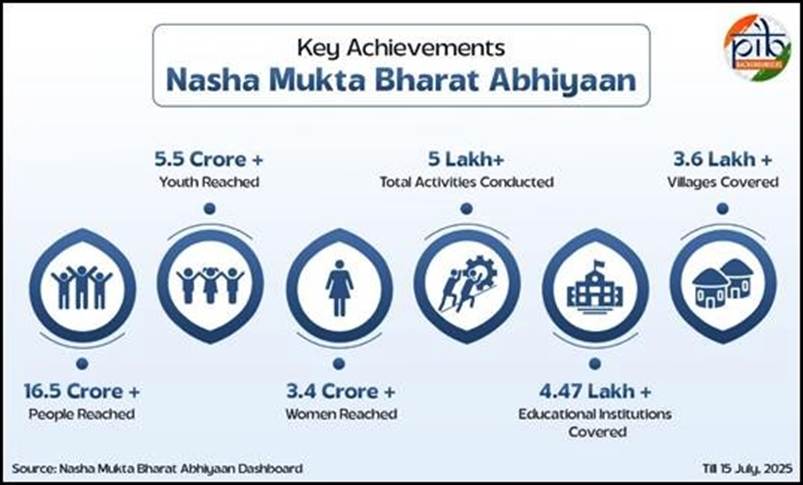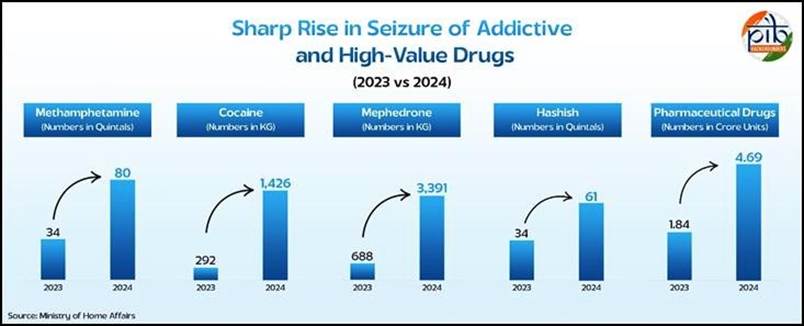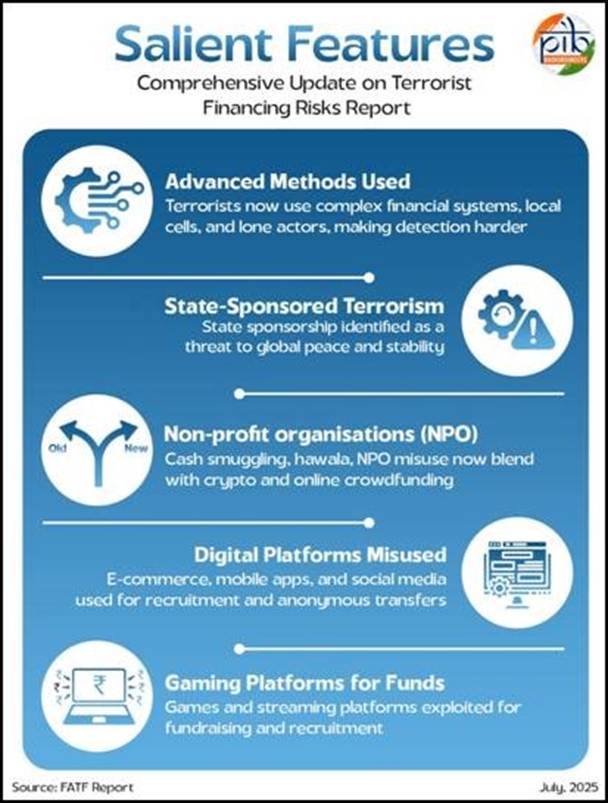Content
- Nasha Mukt Yuva for Viksit Bharat Empowering Minds, Building the Nation
- India’s Commitment to Global Security
Nasha Mukt Yuva for Viksit Bharat Empowering Minds, Building the Nation
India’s fight against drug abuse is entering a transformative phase with youth at the centre of action. The “Nasha Mukt Yuva for Viksit Bharat” initiative mobilises spiritual, institutional, and grassroots forces to build a drug-free, empowered nation.
Relevance : GS 2(Social Issues , Health) , GS 3(Internal Security )
Strategic Vision: Youth as the Torchbearers
- Demographic Dividend: 65% of India’s population is under 35; average age ~28 years — core strength in Amrit Kaal journey.
- Youth-Centric Approach: Substance abuse seen not just as a health issue, but a threat to national development.

Summit Highlights: Youth Spiritual Summit, Varanasi (18–20 July 2025)
- Theme: Nasha Mukt Yuva for Viksit Bharat
- “Kashi Declaration”: A youth-led national roadmap for a drug-free India.
- Institutional Convergence: Ministries (Youth Affairs, Health, Culture, Social Justice), NCB, AIIMS, spiritual organisations & youth networks.
- Review Mechanism: Progress to be assessed in Viksit Bharat Young Leaders Dialogue (VBYLD 2026).

Law Enforcement Outcomes (2024 Data)
- Drugs Seized: ₹25,330 crore — up 55% from ₹16,100 crore in 2023.
- Synthetic Drug Crackdown:
- Methamphetamine, Mephedrone, Cocaine, Hashish — increasingly intercepted.
- 4,134 kg seized from deep seas alone.
- Narco-Terror Nexus: 3,132 kg offshore seizure (largest ever); 700+ kg meth busted in Gujarat; 82.53 kg cocaine in Delhi.
Institutional Strengthening: NCB Reforms
- Expansion:
- Regional Offices: 3 → 7
- Zonal Offices: 13 → 30
- Staff strength increased by 536.
- Nar-K9 Units: Deployed in 10 zonal offices.
- Inter-Agency Coordination: Navy, Coast Guard, BSF, RPF integrated under NDPS Act powers.
Policy and Governance Tools
- 4-Tier NCORD Mechanism: Apex → State → District → Local level.
- Anti-Narcotics Task Forces: Dedicated teams in each State/UT.
- Darknet & Crypto Task Force: MAC-level unit monitoring digital drug trafficking.
- Forensics & Surveillance: National Forensic Support + Maritime Security Group (NSCS, est. 2022).
Public Engagement: Jan Andolan Elements
- Citizen Participation:
- Take digital pledge on NMBA portal.
- Volunteer/intern for awareness & rehabilitation campaigns.
- Share intel with authorities.
- IEC Material: Visual, audio, and digital tools for institutions & public places.
- Tech Platforms:
- NMBA App: Real-time updates, volunteer data.
- MANAS Helpline (1933): 24×7 drug-related support.
- NMBA Portal: FAQs, pledges, expert videos.
Welfare-Oriented Response
- Nasha Mukt Bharat Abhiyaan (NMBA) (launched 15 Aug 2020):
- 16.5 crore+ people sensitised.
- 27.76 lakh individuals treated.
- 730+ free rehab centres; 10,000+ trained Master Volunteers.
- National Action Plan for Drug Demand Reduction (NAPDDR):
- 342 IRCAs: In-patient de-addiction + reintegration.
- 47 CPLIs: Youth life skills and awareness.
- 74 ODICs: Drop-in centres for counselling & referral.
- 83 ATFs & 53 DDACs in government hospitals.
Legal and International Framework
- NDPS Act, 1985: India’s principal anti-drug legislation — strict penalties + rehabilitation provisions.
- Global Cooperation:
- Bilateral talks with Myanmar, Iran, Bangladesh.
- International maritime & land route monitoring.
Conclusion: India’s Vision for a Drug-Free Future
- Aligns with PM’s vision of fit, self-reliant youth for Viksit Bharat.
- Combines policy, enforcement, community mobilisation, and spiritual leadership.
- Shifts from top-down policing to youth-led national movement against substance abuse.
India’s Commitment to Global Security
India, as a responsible global player, has strengthened its anti-money laundering and counter-terrorism financing frameworks in line with FATF standards. Its proactive engagement reflects a deep commitment to securing financial systems from global threats like terror financing and proliferation.
Relevance : GS 2(International Relations)
FATF: Global Standard-Setter Against Financial Crimes
- Established: 1989, G7 Summit, Paris.
- Mandate: Set global standards to combat money laundering, terrorist financing (TF), and proliferation financing (PF).
- Reach: 40 members, 200+ jurisdictions committed to FATF recommendations.
India & FATF
- Observer Status: 2006 | Full Member: June 25, 2010 (34th member).
- Legal Backbone:
- Prevention of Money Laundering Act (PMLA), 2002.
- Unlawful Activities (Prevention) Act (UAPA), 1967.
- Zero-tolerance stance on terror financing & money laundering.
FATF Grey & Black Lists (As of June 13, 2025)
- Grey List: 25 countries (e.g., Nepal, Nigeria, South Africa) under Increased Monitoring.
- Blacklist: 3 nations — North Korea, Iran, Myanmar — under Call for Action.
- Reforms Achieved: 86 of 139 reviewed countries have addressed AML/CFT deficiencies.

FATF Reports: June–July 2025
1. “Complex Proliferation Financing and Sanctions Evasion Schemes”
- New-age PF threats: Use of virtual assets, maritime loopholes, beneficial ownership obfuscation.
- India’s Best Practices: Recognized for multiple PF coordination mechanisms.
- Global Red Flags:
- DPRK’s cyber-heist: $1.5 billion theft (ByBit exchange).
- Pakistan’s National Development Complex flagged for PF links.
- Compliance Gap: Only 16% of assessed countries effective in Immediate Outcome 11 (PF control) — India among few with high/substantial effectiveness.
2. “Comprehensive Update on Terrorist Financing Risks”
- Key Trends:
- Rise in state-sponsored terrorism (India flags Pakistan in NRA 2022).
- Increasing regional decentralisation and fragmented TF networks.
- Emerging TF Methods:
- Crypto, e-commerce, mobile wallets, online crowdfunding.
- Case study: E-commerce used in terror procurement in India.
- Criminal Nexus:
- Terrorists using proceeds of human trafficking, drug smuggling, extortion.
- Microfinancing of lone actors via legal income sources.
- Case study: Indian lone-wolf attack funded via VPN & online payments.
- New-Age Platforms:
- Gaming & streaming platforms for income and recruitment.
- Social media & encrypted apps used for donations & propaganda.

Key Policy Challenges & FATF Recommendations
- Weaknesses Identified:
- Ineffective investigations.
- Poor cross-border cooperation.
- Gaps in financial intelligence use.
- Recommendations:
- Strengthen regulation for virtual assets & social media.
- Enhance public–private partnerships.
- Integrate risk assessments into national frameworks.
- Strengthen regional cooperation & enforcement networks.
India’s Global Role & Commitments
- Recognised by FATF for high compliance in PF detection (IO 11).
- Advocates coordinated response to cyber-financing threats.
- Highlights Pakistan’s continued TF risk — important for India’s counter-terror diplomacy.
- Actively contributes case studies and strategic insights in FATF reports.
Conclusion:
FATF’s recognition of India’s robust legal and institutional mechanisms underscores its leadership in the global fight against financial crimes. By aligning national policy with international standards, India reinforces its role in safeguarding global peace and security.



